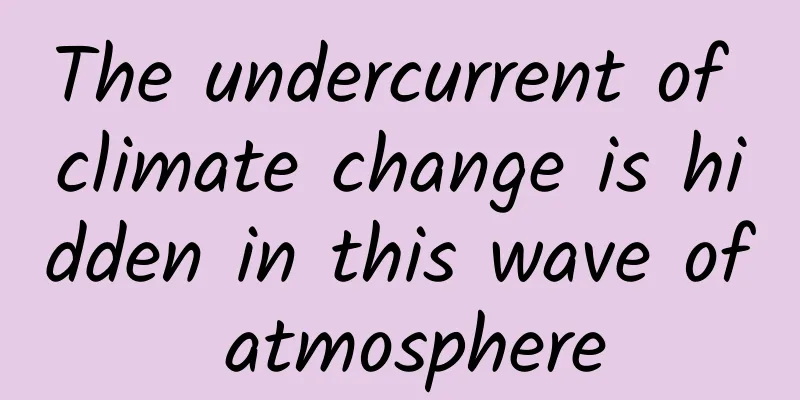The undercurrent of climate change is hidden in this wave of atmosphere

|
Wei Ke We live at the bottom of the Earth's atmosphere. The atmosphere above our heads extends outward to at least 1,000 km. Although the Earth's atmosphere is a whole, the properties and characteristics of each area from bottom to top are different. According to different standards, it can be divided into several levels. The most commonly used stratification standard is based on temperature changes, dividing the Earth's atmosphere into five levels: troposphere, stratosphere, mesosphere, thermosphere and exosphere. The troposphere is the atmospheric range from the earth's surface to the top of the troposphere, with an average thickness of about 11 kilometers. This is the layer of atmosphere closest to the earth's surface, and it is also the layer with the densest and highest air density. The air mass contained in it accounts for 75% of the total atmospheric mass. Almost all water vapor and impurities are in the troposphere, and almost all weather phenomena also occur in this layer. We are not discussing the troposphere today. We are discussing the stratosphere above the troposphere. The range from the top of the troposphere to about 50 kilometers is the stratosphere. The temperature in the stratosphere gradually increases with altitude, which is exactly the opposite of the change in the troposphere. Based on the temperature gradient of the lower atmosphere measured in the 19th century (0.7 degrees Celsius/100 meters), many physicists at the time believed that as the altitude increased, the temperature of the atmosphere would drop to extremely low values. For example, German physicist Hermann von Helmholtz believed that at altitudes above 30 km, the temperature might be close to absolute zero and the internal energy might completely disappear. In fact, this is impossible to achieve, because as the altitude increases, although the heat source is getting farther and farther away from the ground, the composition of the atmosphere will gradually change, and the content of ozone in the atmosphere will gradually increase. Ozone is mainly generated by oxygen in the atmosphere absorbing ultraviolet rays from the sun. 90% of the ozone in the atmosphere is concentrated within a range of 20-30km from the ground. This layer is the ozone layer. Although ozone does not absorb sunlight visible to our naked eyes, it can absorb ultraviolet rays that are invisible to our naked eyes. After absorbing ultraviolet rays, the atmospheric temperature of the ozone layer will gradually increase. Therefore, as the altitude increases in the stratosphere, the temperature gradually rises. As the altitude increases, the temperature also gradually increases, which forms a temperature distribution that is cold below and hot above. This is a very stable state. Therefore, the air in this air layer rarely moves vertically, and mainly moves horizontally, so it is called the stratosphere. Because the air flows horizontally and the up and down turbulence is very weak, it is very suitable for aircraft flight. Current commercial aircraft and high-altitude reconnaissance aircraft mainly fly in the lower stratosphere and upper troposphere. So, the stratosphere is the blue area above all the clouds we can see. Because there are not many rising and falling air movements here, there are not many weather phenomena here. Some friends may say, if there are not many phenomena, what is the point of studying it? In fact, the stratosphere is closely related to our lives, especially the ozone layer located between 20 kilometers and 30 kilometers. It provides us with an omnipresent and omnipresent sunshade, isolating most of the ultraviolet rays from the sun. The most cosmic radiation that the earth can receive is sunlight. Everyone thinks that sunlight is warm, pure, and bright. In fact, sunlight contains a lot of light that is invisible to the human eye, such as ultraviolet rays. According to the wavelength from long to short, ultraviolet rays can be divided into UVA, UVB and UVC, among which UVC is the most dangerous ultraviolet. Under the long-term exposure of UVC, no life can survive. We often hear about ultraviolet disinfection lamps and black light lamps. In fact, the light emitted by these lamps is UVC that is invisible to the naked eye. It can be used for disinfection and sterilization. What effects does UVB have? Long-term exposure to UVB can easily cause skin cancer and cataracts. Every year, many people die from skin cancer and become blind from cataracts around the world. As for UVA, many people who love beauty hate it very much, because under the irradiation of UVA, the skin can easily age, darken, and develop wrinkles, and aging starts from the skin. Fortunately, humans are very lucky, because the stratosphere above our heads is like a big umbrella, it protects us everywhere and at all times. The ozone layer can block 100% of the most dangerous UVC, more than 50% of UVB, and part of UVA. Therefore, the ultraviolet rays that can reach the earth's surface are only a small part of the ultraviolet rays, but this small part is useful for our health. Lack of ultraviolet radiation can easily lead to vitamin D and calcium deficiency in people, leading to osteoporosis, rickets, osteomalacia, motor retardation, tetany, etc. The movement of the stratosphere has some distinct characteristics. For example, in the mid-latitude and high-latitude regions, there is an easterly circulation for about half a year, and a westerly circulation for the other half a year. So, if you look from above the Arctic in the summer, you will see a clockwise circulation; in the winter, you will see a counterclockwise circulation. The wind speed in the stratosphere is very strong. How strong is it? It is stronger than the wind speed of all typhoons and hurricanes on the earth. The wind speed in the jet stream area can even reach more than 100 meters per second. This jet stream forms a confinement circle for high-latitude cold air, controlling the cold air in the dark and cold polar region. When a large-scale disturbance occurs on the jet stream, the jet stream is twisted, and cold air will pour southward. Just like a basin of water rotating steadily, the water inside cannot spill out, but when the basin itself is unstable and bumpy, it is easy to spill the water inside. For example, at the end of January 2016, the eastern part of my country was extremely cold, and even Guangdong and Taiwan had snow, which was called a "super cold wave" by netizens. If you observe the stratosphere a week or two before the "super cold wave", you will see that the entire polar vortex is distorted and cold air is gushing out continuously. North America was extremely cold in January 2019, and it felt like we had suddenly entered the Ice Age. This is because in January, the center of the Arctic polar vortex was split and moved over North America, which caused the unusually cold weather in North America. Similarly, in early January 2021, the earth encountered extreme cold air in eastern my country. On the morning of January 7, the lowest temperature in most parts of Beijing was between -24 and -18°C, and the lowest temperature at the Nanjiao Observatory was -19.6°C, which was the lowest winter value since 1966 (-27.4°C, February 22, 1966). Prior to this, there was an explosive warming in the stratosphere, and the polar vortex was pushed out of the Arctic and shifted to the sky over Siberia, thereby pouring out the cold air from the Arctic and Siberia in the polar regions. So, I metaphorically describe the stratosphere as “the engine of global cold air, especially extreme cold air.” In addition, the stratosphere is also an amplifier of global climate change, which can amplify climate anomalies in one region into global climate anomalies and short-term climate anomalies into long-term climate anomalies. For example, when a volcano erupts, the ash and magma emitted by the volcano mainly affect the local area of the volcano. When the volcanic eruption is particularly strong, a large amount of sulfate aerosols enter the stratosphere and are transported to various places around the world along with the atmospheric circulation in the stratosphere. Since the stratosphere lacks vertical movement, these aerosols can remain in the stratosphere for a long time, blocking solar radiation, forming a parasol effect, reducing solar radiation on the ground, and forming a global long-term cooling process. This amplifies local short-term events into long-term global climate events. In the past half century, the eruption of Mount Agung in 1963 released about 8 million tons of sulfur dioxide into the stratosphere, the eruption of El Chichon in 1982 released about 7 million tons of sulfur dioxide into the stratosphere, and the eruption of Mount Pinatubo in 1991 released about 20 million tons of sulfur dioxide into the stratosphere. These three volcanic eruptions have left their mark on the global temperature sequence, with cooling amplitudes of about -0.2°C, about -0.2°C and about -0.5°C, respectively, and lasting for 1-2 years. Larger eruptions, such as the eruption of Mount Tambora on the Indonesian island of Sumbawa in April 1815, sent an ash column 45 km high (into the upper stratosphere), blanketing the globe with volcanic aerosols, killing more than 71,000 people in Southeast Asia, 11,000-12,000 of them directly from the eruption, and the rest from famine and disease. Thousands of miles away in Europe, famine killed more than 200,000 people. This amplification effect also applies to black carbon aerosols produced by large-scale wildfires and nuclear winter caused by nuclear war. The so-called nuclear winter means that nuclear weapons will cause the black smoke (black carbon) produced by the burning of flammable materials to be ejected into the stratosphere, diffused to the world through stratospheric circulation, block solar radiation, cause the ground to cool down, and make the surface of the earth present severe winter weather. A few years ago, scientists conducted such numerical experiments to simulate a small nuclear war. For example, India and Pakistan launched a war for some reason. India dropped 50 nuclear warheads and Pakistan also dropped 50 nuclear warheads. 100 nuclear warheads caused 100 fires and 100 cities were destroyed. The nuclear warheads in the simulation were very small, with a TNT equivalent of only 15,000 tons, which is equivalent to the atomic bomb "Little Boy" dropped by the United States on Hiroshima, Japan during World War II. Even a small nuclear war simulated in the experiment would inject about 5 million tons of black carbon into the world. After entering the stratosphere, it would quickly spread throughout the stratosphere within half a year, from the South Pole to the North Pole, blocking solar radiation. Because the atmosphere in the stratosphere mainly moves horizontally and the air is very stable, even 10 years later, there will still be about 1.1 million tons of black carbon in the atmosphere. It will cause global climate impacts, the most important manifestation of which is that it will affect agriculture. The results of scientists' simulations show that the agriculture of the United States and China, which did not participate in the war, would also be seriously affected: in the first five years of the war, China's winter wheat production might decrease by 40%, and spring wheat production might decrease by about 35%; the United States' corn production might decrease by about 20%. In the second five years, the reduction in corn and soybean production in the United States was about 10%; the reduction in grain production in China was about 15% to 25%. Many people who study international politics should know that if crop production decreases to this extent, it will inevitably lead to a global food crisis and soaring prices, which will have the greatest impact on the poor. What if the war is larger, with 1,000 nuclear warheads? About 50 million tons of black carbon will be ejected into the stratosphere, and the global temperature will drop by about 3°C. If the number of nuclear warheads exploded increases to 3,000, the global temperature will drop by about 7°C. The current global average temperature is 15℃. If it drops by 7℃, it will go directly from a spring of 15℃ to a winter of about 8℃. A real nuclear winter will come. Therefore, the stratosphere above our heads is very important to us. It can amplify the climate impacts caused by various man-made or natural processes. In a nuclear war, even if we are thousands of miles away from the war, the transport effect of the stratosphere above our heads and the response of the global climate will also cause global impacts. Under the shadow of nuclear war, no country can be immune. In summary, the stratosphere is the engine of extreme cold air around the world. At the same time, it provides us with an omnipresent and omnipresent sunshade, making the earth more habitable. At the same time, it is an amplifier of the global climate, affecting abnormal events in the stratosphere, which will eventually affect the world. Reviewer: Huangfu Jingliang, typhoon expert at the Institute of Atmospheric Physics, Chinese Academy of Sciences This article is produced by Science Popularization China-Starry Sky Project (Creation and Cultivation). Please indicate the source when reprinting. |
<<: Have you ever seen the golden lotus blooming from the soil?
Recommend
Short video operation: How to create a personalized popular celebrity brand?
After becoming popular, only a small number of ce...
Form costs reduced by 30%, home decoration advertising case!
With the further deepening of regulation and cont...
9 basic methods for brand marketing data analysis!
"What is your methodology for data analysis ...
The formula for becoming a Tik Tok influencer worth $1 million!
Tik Tok has become more and more popular, and var...
Basic dance moves lead to lower limb paralysis? Dangerous "bending back"
|| || Written by reporter Lv Bingxin Photo and te...
In-depth | In 2019, which marketing trends will kill you?
As usual, I list my guesses about the marketing t...
US brokerage firm upgrades Intel rating, says PC market may be over
U.S. brokerage firm Northland Capital Markets tod...
Thinking + sense of rhythm + refinement, see how excellent operations widen the gap with ordinary operations?
In this article, we will talk about the differenc...
Pinduoduo’s method of improving user conversion rate!
Pinduoduo, an e-commerce company, achieved revenu...
One pound of durian contains two pounds of "carbon". How do agricultural scientists measure carbon emissions reduction for domestic durian?
Xinhua News Agency Haikou, July 21 (Reporter Chen...
What are those little insects flying around the trash can at home? Flies? No.
When the trash can at home has not been emptied f...
Latest research: Garlic can really lower blood lipids and blood sugar, but the premise is...
Recently, a new study has been circulated online,...
Apple's multi-camera shooting feature is here, but only these six iPhones can use it
At last year's fall conference, Apple demonst...
One person dies from it every minute...If you experience these symptoms in your body, be careful!
Statistics show that the number of people who die...









